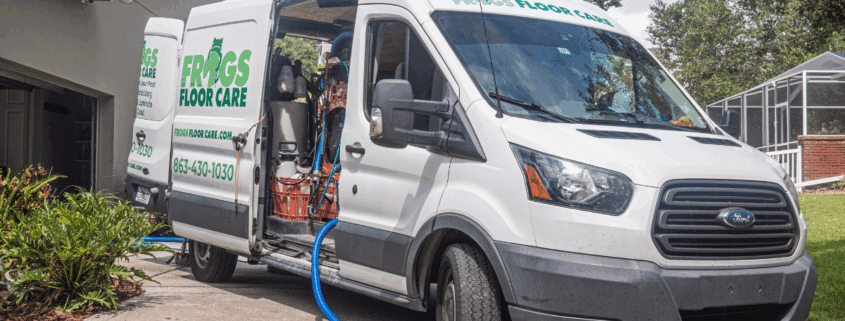Upholstery Care Guide: How to Clean & Protect Every Fabric
Is your favorite sofa showing signs of wear? Are you noticing your upholstered furniture doesn’t look as vibrant as it once did? Florida’s unique climate presents special challenges for maintaining upholstery, from high humidity to intense sunlight that can accelerate fabric deterioration.
As Frogs Floor Care has served Tampa Bay and Central Florida since 1992, we’ve seen firsthand how proper upholstery care can dramatically extend the life of your furniture investments. In this comprehensive guide, we’ll share our expertise on cleaning and maintaining every type of upholstery fabric, with special attention to the challenges Florida homeowners face.
Understanding Your Upholstery Fabric Types
Before attempting any cleaning, it’s crucial to identify what type of fabric covers your furniture. Different materials require specific cleaning approaches to prevent damage.
Natural Fabrics
Cotton: Durable and versatile, cotton upholstery is common in Florida homes thanks to its breathability in our warm climate. However, cotton can shrink if cleaned improperly and is susceptible to mildew in high humidity.
Linen: Prized for its elegant appearance and cooling properties, linen requires gentle care. This fabric wrinkles easily and can develop mildew problems in Florida’s humid environment.
Wool: Less common in Florida due to its warmth, wool upholstery is nonetheless found in many homes. It’s naturally stain-resistant but requires special care to prevent shrinking and moth damage
Silk: The most delicate natural fabric, silk upholstery demands professional cleaning. Florida’s humidity and sunlight can quickly damage silk if not properly protected.
Leather: While technically not a fabric, leather upholstery is a popular choice that requires specific maintenance to prevent cracking and fading, especially in Florida’s intense sunlight.
Synthetic Fabrics
Microfiber: Extremely popular for its durability and stain resistance, microfiber is well-suited to Florida homes with children and pets. It’s relatively easy to clean but requires specific techniques.
Polyester: Resistant to wrinkling and fading, polyester blends stand up well to Florida’s climate. They’re generally easier to clean than natural fibers.
Nylon: One of the strongest synthetic fibers, nylon resists wear and abrasion. It performs well in high-traffic homes but can fade in direct sunlight.
Acrylic: Often used as a wool substitute, acrylic is resistant to sunlight damage, making it ideal for Florida sunrooms and patios.
Olefin: Extremely durable and stain-resistant, olefin handles Florida’s humidity well and is often used in outdoor furniture.
Decoding Cleaning Codes
Most upholstered furniture comes with a tag featuring cleaning codes. Understanding these codes is essential:
- W: Water-based cleaning solutions only
- S: Solvent-based cleaners only (dry clean)
- WS: Either water-based or solvent cleaners
- X: Vacuum only, no cleaning solutions
Always check these codes before attempting any cleaning to avoid damaging your furniture.
Florida-Specific Upholstery Challenges
Living in Lakeland and Central Florida presents unique challenges for upholstery maintenance:
High Humidity Effects
Florida’s notorious humidity can wreak havoc on upholstery. Excess moisture in the air can lead to:
- Mildew and mold growth within fabric fibers
- Musty odors that penetrate deep into cushions
- Weakening of natural fibers over time
- Color bleeding or fading in some fabrics
Pro Tip: Maintain indoor humidity levels between 40-60% using dehumidifiers or air conditioning to protect your upholstery investments.
Sun Damage Prevention
With over 230 sunny days per year in Lakeland, UV exposure is a major concern:
- Fading colors, particularly in natural fibers and dark colors
- Weakening fabric fibers, leading to tears and splits
- Drying out and cracking leather upholstery
- Accelerated deterioration of fabric backing
Pro Tip: Position upholstered furniture away from direct sunlight or use window treatments that block UV rays. Consider furniture covers for periods when rooms receive intense sunlight.
Seasonal Considerations
Florida’s weather patterns require adjusting your upholstery care throughout the year:
- Rainy Season (June-September): Increase ventilation and check for dampness
- Dry Season (October-May): Monitor for dust accumulation and static electricity
- Hurricane Season: Have a plan to protect valuable furniture from potential water damage
Fabric-Specific Cleaning Methods
Each upholstery material requires a tailored approach to cleaning. Here’s how to care for the most common fabrics found in Florida homes:
Microfiber Upholstery Care
Microfiber is extremely popular in Florida homes due to its durability and resistance to stains. To clean microfiber upholstery:
- Vacuum thoroughly using an upholstery attachment to remove dust and debris
- Check the cleaning code on the furniture tag
- For W coded microfiber:
- Mix a few drops of mild dish soap with warm water
- Use a clean white cloth to gently blot the solution onto stained areas
- Avoid saturating the fabric
- Blot with a clean, damp cloth to remove soap residue
- Allow to air dry completely
- For S coded microfiber:
- Use only solvent-based cleaners like rubbing alcohol or dry-cleaning solvent
- Apply with a clean white cloth, working in small sections
- Brush the fabric with a soft brush once dry to restore texture
- Mix a few drops of mild dish soap with warm water
- Use a clean white cloth to gently blot the solution onto stained areas
- Avoid saturating the fabric
- Blot with a clean, damp cloth to remove soap residue
- Allow to air dry completely
- Use only solvent-based cleaners like rubbing alcohol or dry-cleaning solvent
- Apply with a clean white cloth, working in small sections
- Brush the fabric with a soft brush once dry to restore texture
Pro Tip: Always test any cleaning solution on an inconspicuous area first.
Leather Upholstery Maintenance
Leather furniture requires special attention in Florida’s climate to prevent drying, cracking, and fading:
- Dust regularly with a soft, dry cloth
- Clean spills immediately by blotting (never wiping) with a clean, slightly damp cloth
- Deep clean twice yearly with a leather cleaner specifically formulated for your leather type
- Condition quarterly with a quality leather conditioner to replenish moisture
- Keep away from direct sunlight and heat sources
- Maintain distance from air conditioning vents to prevent excessive drying
Pro Tip: For leather in Florida homes, conditioning is even more important than cleaning due to our dry air conditioning environments.
Cotton and Linen Care
These natural fibers are comfortable in Florida’s heat but require careful maintenance:
- Vacuum weekly to remove surface dust and prevent it from settling into fibers
- Treat spills immediately by blotting with a clean, white cloth
- Avoid over-wetting as these fabrics can shrink or develop water rings
- For water-safe fabrics:
- Mix a solution of mild soap and warm water
- Apply with a soft brush in a circular motion
- Rinse by blotting with clean water
- Use fans to speed drying and prevent mildew
- Mix a solution of mild soap and warm water
- Apply with a soft brush in a circular motion
- Rinse by blotting with clean water
- Use fans to speed drying and prevent mildew
Warning: Never use hot water on cotton or linen upholstery as it can cause shrinkage and color bleeding.
Synthetic Blend Care
Polyester, nylon, and acrylic blends are common in Florida homes due to their durability:
- Check the care tag for specific cleaning instructions
- Vacuum regularly to remove dust and allergens
- For water-safe blends:
- Mix a small amount of mild detergent with cool water
- Use a soft cloth to gently clean, avoiding saturation
- Blot with clean water to remove soap residue
- Allow to dry completely before use
- Mix a small amount of mild detergent with cool water
- Use a soft cloth to gently clean, avoiding saturation
- Blot with clean water to remove soap residue
- Allow to dry completely before use
Pro Tip: For stubborn stains on synthetic fabrics, a mixture of equal parts white vinegar and water can be effective, but always test in an inconspicuous area first.
Velvet and Chenille Upholstery
These luxurious fabrics require special attention:
- Use a soft brush attachment when vacuuming to avoid crushing the pile
- Blot spills immediately without rubbing
- Steam clean with an upholstery steamer for gentle, effective cleaning
- Brush in the direction of the nap after cleaning to restore appearance
Regular Maintenance Tips
Preventative care is the key to extending the life of your upholstered furniture in Florida:
Weekly Maintenance
- Vacuum thoroughly using upholstery attachments to remove dust, allergens, and food particles
- Rotate cushions to ensure even wear, especially in areas with direct sunlight
- Brush fabrics with a soft upholstery brush to remove pet hair and prevent dirt buildup
Monthly Maintenance
- Inspect for stains or spots and treat them promptly
- Check for pest activity (Florida’s climate can attract fabric-damaging insects)
- Clean arms and headrests where body oils tend to accumulate
Quarterly Maintenance
- Deep clean high-use areas like armrests and seat cushions
- Apply fabric protector to guard against stains and liquid spills
- Condition leather furniture to prevent drying in air-conditioned environments
Annual Maintenance
- Schedule professional cleaning with upholstery cleaning experts to remove deep-down soil and contaminants
- Inspect for structural issues like sagging cushions or loose joints
- Evaluate sun exposure and rearrange furniture if fading is occurring
Professional vs. DIY Cleaning
While regular maintenance can be handled at home, there are significant advantages to professional upholstery cleaning, especially in Florida’s challenging climate:
Benefits of Professional Cleaning
- Deep extraction removes embedded dirt, allergens, and dust mites
- Specialized equipment provides thorough cleaning without over-wetting
- Expert knowledge of different fabric types prevents damage
- Professional-grade products tackle tough stains without harming fibers
- Faster drying times reduce the risk of mildew in Florida’s humidity
When to Call the Professionals
Consider professional upholstery cleaning from Frogs Floor Care when:
- Your furniture has not been professionally cleaned in over a year
- You notice persistent odors that vacuuming doesn’t eliminate
- Allergies seem to worsen when using certain furniture
- Stains have not responded to DIY cleaning attempts
- You’re preparing for a special event or holiday entertaining
- After water exposure or high humidity events
Our certified technicians understand the unique challenges Florida homeowners face and use safe, effective methods to clean and protect your valuable furniture.
Stain Removal Guide for Common Florida Problems
Florida living presents unique stain challenges. Here’s how to address them:
Sunscreen Stains
Those white, oily marks from sunscreen can be challenging:
- Blot excess with a clean cloth
- Apply a small amount of dish soap mixed with water
- Gently blot (don’t rub)
- Rinse by blotting with clean water
- Allow to air dry
Beverage Spills
Sweet tea, coffee, and fruit drinks are common culprits:
- Blot immediately with clean, white cloths
- Mix 1 tablespoon white vinegar with 2/3 cup rubbing alcohol
- Dab solution onto the stain
- Blot with clean water and allow to dry
Mold and Mildew
Florida’s humidity can lead to mold issues:
- Take furniture outside on a sunny day if possible
- Vacuum thoroughly
- Mix equal parts rubbing alcohol and water
- Lightly apply to affected areas
- Allow to dry completely in sunlight if fabric permits
Warning: For severe mold issues, professional cleaning is strongly recommended to ensure complete removal and prevent health issues.
Protecting Your Upholstery Investment
Prevention is always easier than cleaning. Here are effective strategies to protect your furniture:
Fabric Protection Products
Professional-grade fabric protectors create an invisible barrier against stains:
- Apply after professional cleaning for maximum effectiveness
- Reapply annually or after deep cleaning
- Choose products specifically formulated for your fabric type
Strategic Furniture Placement
- Position upholstered pieces away from direct sunlight
- Keep furniture at least 2 feet from air conditioning vents
- Use window treatments that block UV rays during peak sun hours
Slipcovers and Throws
- Consider washable slipcovers for furniture in high-traffic areas
- Use decorative throws to protect areas that receive the most use
- Opt for moisture-wicking fabrics designed for Florida’s climate
When to Replace vs. Reupholster
Sometimes cleaning isn’t enough. Here’s how to decide whether to reupholster or replace:
Consider Reupholstering When:
- The furniture frame is solid and well-constructed
- The piece has sentimental or antique value
- The cost of reupholstering is less than replacement
- You want a specific fabric or design not available in new furniture
Consider Replacing When:
- The frame is damaged or weakened
- The furniture is uncomfortable despite cushion replacement
- The cost of reupholstery exceeds 70% of a new purchase
- The style no longer suits your needs or preferences
Trust the Upholstery Experts at Frogs Floor Care
At Frogs Floor Care, we’ve been serving the Tampa Bay and Central Florida regions since 1992. Our team understands the unique challenges Florida homeowners face when maintaining upholstered furniture. From humidity and sun damage to seasonal considerations, our certified technicians have the expertise to clean, protect, and restore your valuable furniture investments.
We use safe, effective cleaning methods tailored to each specific fabric type, ensuring the best possible results without risking damage. Our approach focuses on not just cleaning but also protecting your upholstery against future stains and wear.
Ready to give your upholstered furniture a fresh, clean start? Contact Frogs Floor Care today at 813-960-3764 or 863-430-1030 to schedule your professional upholstery cleaning service. We treat our customers like family, and we’ll help you maintain beautiful, healthy upholstery for years to come!






